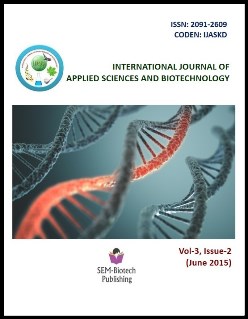Phenotypic Diversity of Nepalese Finger Millet (Eleusine coracana (L.) Gaertn.) Accessions at IAAS, Rampur, Nepal
DOI:
https://doi.org/10.3126/ijasbt.v3i2.12413Keywords:
Fingermillet diversityAbstract
An experiment was conducted at Institute of Agriculture and Animal Science (IAAS), Rampur, Nepal during July 2011 to September 2011 with an objectine to determine phenotypic variability of Nepalese finger millet landraces using descriptive statistics, cluster analysis and principal component analysis. F- Value of REML procedure of mixed model analysis revealed that highly significant variation was observed in all studied 17 traits. Grain yield per plant was positive and highly significant correlated with grain yield per ear (0.769**) followed by plant height (0.529**), productive tillers number (0.473**), days to maturity (0.471**), days to heading (0.460**), days to flowering (0.457**), straw yield per plant (0.348**), finger number per ear (0.320**), thousand kernel weight (0.281**), flag leaf sheath width (0.230**) and finger length (0.211**). The ear shape (H’= 3.42) followed by grain color (H’= 3.35) showed high genetic diversity after estimated by using Shannon- Weaver index. 46% open type ear shape, 40% light brown grain color, 66% non-pigmentation, 70% absence of inflorescence branch and 54% absence of finger branch were found dominant to other on studied accessions. The distribution pattern was observed by using Ward’s minimumvariance method into five clusters. The number of accessions in a cluster was ranged from 18 in cluster IV to 1 in cluster V. The cluster V (accession no. 10996) and III (accessions no. 431 and 11024) showed early phenological traits, lowest in finger length, finger width, finger number per ear, thousand kernel weight, grain yield per ear and grain yield per plant. The cluster II and IV showed late maturity type, long finger length and width, high in finger number per ear, grain yield per ear, grain yield per plant and plant height. The first five principal components accounted for 74.9% of total variance among 50 accessions. Most of variation was contributed from phenological characters, plant height, grain yield per ear, finger length, finger width, finger number per ear and productive tillers number. These traits were positively correlated with grain yield and can be used in selection for breeding programs.
Int J Appl Sci Biotechnol, Vol 3(2): 285-290
DOI: http://dx.doi.org/10.3126/ijasbt.v3i2.12413




